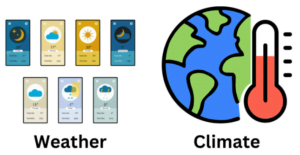Climate Change: The Basics Explained
What is Climate Change?
According to the NASA definition, climate change “describes a change in the average conditions…over a long period of time.”
When considering “average conditions” this describes average temperatures, rainfall patterns, snowfall patterns, the occurrence of natural disasters, the severity of natural disasters, and more.
NASA scientists have been observing that Earth’s surface is warming, and many of the warmest years on record have happened in the past 20 years, hence the name global warming.
Weather vs. Climate

In order to properly understand climate change, it is important to understand the distinction between the terms weather and climate.
NASA describes the weather as the conditions outside at a specific time in a specific place. For example, if you look outside your window and notice that it is raining, that is a way to describe the current weather.
Examples of weather events include rain, snow, wind, hurricanes, tornadoes, etc.
Climate describes the weather conditions that are expected in a region at a particular time of year. Climate looks at a longer period of time for its analysis and observes expected patterns based on past years.
The climate of a region is determined by observing its weather over a period of many years. Is it usually hot or usually cold? This question can help determine the climate of some regions.
Climate Change Explained

In general terms, climate change describes a change in the climate of a region over a long period of time. When examining climate change, looking at a period of 4-5 years is not sufficient. One must look at long-term patterns to establish the impacts of climate change.
The term “global climate change” refers to the average long-term condition changes over the entire Earth. The general patterns have been changes in precipitation, as well as the Earth’s warming. The results have been:
- Rising sea levels (because of melting glaciers and ice)
- Shrinking mountain glaciers (melting due to warming temperatures)
- Ice melting at a faster rate than usual (Greenland, Antarctica, Arctic – causes rising sea levels)
- Changes in flower and plant blooming times (impacts feeding patterns of animals, impacts their livelihood)
Though a large part of climate change is induced by humans, it is important to recognize that the climate of the Earth has been changing long before humans were alive. Look at the Ice Age, for example.
These changes were induced by nature and other external factors. However, when it comes to climate change, there is solid evidence that it is caused by overconsumption and wasteful practices of humans.
Scientists have been able to observe unusual changes recently, including the fact that the average temperature of Earth has been increasing much more quickly than they would expect over the past 150 years.
What are the causes of climate change?
There are many causes of climate change, and they are extremely intricate. Here, I will explain the basic causes of climate change, rather than delving into the specifics.
The Greenhouse Effect
Earth is surrounded by an invisible layer called the atmosphere. The atmosphere is composed of certain gases that block heat from escaping.
This is known as the greenhouse effect. The gases that form the atmosphere keep Earth warm the same way the glass in a greenhouse is able to keep plants warm.
Human activities that are releasing excessive greenhouse gas emissions are changing the natural greenhouse. These changes are causing the atmosphere to trap more heat than it used to because more heat is being released.
This is leading to a warmer planet – global warming. Some human activities that are causing the change of the natural greenhouse: (all of the reasons are not listed, but these are some of the most prominent ones)
- Excessive burning of fuel
The excessive burning of fuel releases certain greenhouse gases, such as CO2, into the atmosphere. As explained above, this leads to a change in the natural greenhouse and releases more heat into the atmosphere. This leads to a warmer planet.
2. Deforestation
Allowing large amounts of forest to be cut down also causes global warming and climate change. Trees are well known to be able to absorb certain greenhouse gases, especially CO2.
As deforestation becomes a popular way to make more space for cities, factories, and other ventures, the number of trees has been drastically reduced. A good example of this is the deforestation of the Amazon Rainforest, also known as the lungs of Earth.
Without trees to absorb the greenhouse gases, they go into the atmosphere, leading to changes in the natural greenhouse.
- Plastic consumption
Excessive plastic consumption is also one of the leading causes of changes in the natural greenhouse. Plastic is extremely energy-intensive to produce. This results in high amounts of greenhouse gases released while producing plastic.
Besides this, however, plastic is discarded at extremely high rates. In order to get rid of this plastic it is often burned or left in landfills.
When plastic is burned it releases high amounts of greenhouse gases into the atmosphere. When it is left in landfills, toxic chemicals are released into the soil and atmosphere because plastic takes so long to decompose.
- Methane
Due to its structure, methane traps more heat in the atmosphere per molecule than carbon dioxide, making it 80 times more harmful than CO2 for 20 years after it is released.
There are many activities that release methane. Anthropogenic emission sources include:
- Landfills
- Oil and natural gas systems
- Agricultural activities (cows)
- Coal mining
- Stationary and mobile combustion
- Wastewater treatment
- Certain industrial processes
Impact of climate change
The impacts of climate change are dangerous and far-reaching. It is the reason that we have seen such irregular rainfall patterns, extreme weather conditions, and severe natural disasters over the last few years.
Not only are these conditions threats to our homes, but they are also threats to the rest of our livelihoods as well. Without regular rainfall patterns, it is difficult for farmers to grow crops, leaving us with fewer food options.
In addition, extreme heat has led to widespread wildfires across the world. This has led to further deforestation and the destruction of many homes – for both animals and humans.

